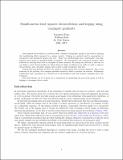Simultaneous least squares deconvolution and kriging using conjugate gradients
Author(s)
Kane, Jonathan; Rodi, William; Toksoz, M. Nafi
Downloadkane1.pdf (1.979Mb)
Other Contributors
Massachusetts Institute of Technology. Earth Resources Laboratory
Metadata
Show full item recordAbstract
Least squares deconvolution is a method used to sharpen tomographic images of the earth by undoing the bandlimiting effects imposed by a seismic wavelet. Kriging is a method used by geoscientists to extrapolate and interpolate sparse data sets. These two methodologies have traditionally been kept separate and viewed as unrelated fields of research. We demonstrate the connection between these methods by deriving them both as examples of linear inversion. By posing the methods in this way we can define a joint inverse problem in which observed values of reflectivity in wells are used to improve deconvolution, and, conversely, seismic data is used to help extrapolate well data.
Solving this joint problem involves the solution of large sparse sets of linear equations. Due to the structure of the problem, the conjugate gradients method is ideal to perform the solution. Preliminary results show that convergence to a solution for a 3-D problem is fast and accurate, requiring only a few iterations.
This methodology can be of great use to interpreters by sharpening the post stack image as well as helping to tie seismic data to wells.
Date issued
2001Publisher
Massachusetts Institute of Technology. Earth Resources Laboratory
Series/Report no.
Earth Resources Laboratory Industry Consortia Annual Report;2001-04
Keywords
Inversion